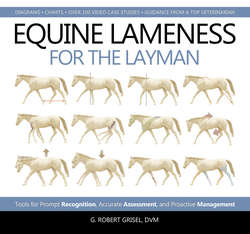Читать книгу Equine Lameness for the Layman - G. Robert Grisel DVM - Страница 42
На сайте Литреса книга снята с продажи.
9 Weight-Bearing versus Non Weight-Bearing Lameness
ОглавлениеCharacterizing the nature of the horse’s lameness is one of the key objectives of effective visual examination. Achieving this task in conjunction with identifying the lame limb(s) comprises the foundation of any satisfying assessment. This is because there tends to be a healthy correlation between the nature of a horse’s lameness and the general location of its source (fig. 9.1). For instance, we can usually rule out a foot problem in a horse exhibiting purely non weight-bearing lameness in a forelimb. On the other hand, if the same horse subsequently develops severe unilateral weight-bearing lameness a few days after being reshod, there’s a good chance that the issue can be successfully addressed with the help of the farrier. This region-specific information becomes invaluable as we navigate through the examination process.
9.1 Relationship Between Limb Region and Nature of Corresponding Lameness
Problems originating below the level of the fetlock joint(s) usually produce weight-bearing lameness. Pathology involving structures within the horse’s upper limb often generate non weight-bearing lameness. Issues affecting the horse’s mid-limb commonly manifest as combination lameness, comprising both weight-bearing and non weight-bearing components.
As you’ll learn in chapter 15 (p. 85), there is also a close relationship between the nature of a horse’s lameness and the physical design of the structure that is causing it: structures that undergo load-bearing stress (i.e. bear weight) have the capacity to produce weight-bearing lameness, whereas structures that change their shape during movement tend to generate non weight-bearing lameness (fig. 9.2).
9.2 Relationship Between Anatomic Role and Nature of Corresponding Lameness
A. Structures that “feel” the load of the horse’s weight have the potential to generate weight-bearing lameness.
B. Structures that change shape as the horse moves have the potential to generate non weight-bearing lameness.
Knowledge of this interrelationship enables the experienced observer to more easily decipher the true cause of a problem amongst a myriad of possibilities—all based solely on the way the horse moves. This can be achieved by using the nature of the horse’s lameness to reveal the primary function(s) of its source (fig. 9.3 and VL 9a). For example, the differences in the physical roles of the cannon bone and fetlock joint with regard to load bearing and movement will be reflected in the weight-bearing versus non weight-bearing characteristics of the horse’s gait, respectively. Appropriately, issues affecting these structures can often be discriminated without the assistance of local anesthesia (blocks) or diagnostic images.
Figure 9.3 Disclosure of Anatomic Function Based on the Nature of Lameness
VL 9a Scan/Click to view video. www.getsound.com/tutorials/9a
As you can see, determining the nature of a horse’s lameness is a critical part of our inspection methodology in view of the valuable diagnostic clues that this intelligence provides. Fortunately, this exercise is relatively simple for the informed observer. Several visual markers that are unique to both weight-bearing and non weight-bearing issues enable one to judge the nature of most gait deficits with confidence. The majority of these indicators, which will be highlighted in chapter 24 (p. 170), are relatively obvious once we know which aspects of the horse’s gait demand special attention.
